

The Ultimate Comparison Guide on DevOps vs Agile for 2025






Agile emphasizes a structured, iterative approach with careful attention to detail, ensuring each step is executed correctly. DevOps, on the other hand, focuses on real-time collaboration, tool integration, and continuous adjustments to streamline processes and achieve seamless outcomes.
Both methods aim to build, but they approach it differently. So, when we talk about DevOps vs Agile, we’re exploring how these methodologies can coexist, complement each other, or take on different challenges in software development.
In this blog, we will examine their distinctions and similarities and how they affect the process of transforming an idea into a final product.
Agile project management has been developed in contrast to rigid methodologies. It favors iterative development, where tasks progress in small, measurable increments. The teams always check if the product being delivered will meet the client’s needs and desires and make the necessary changes whenever required. This approach is partnership-oriented, flexible, and focuses on learning.
DevOps, however, bridges the gap between development and operations. By promoting collaboration between these two traditionally separate teams, DevOps aims to improve efficiency, reduce silos, and accelerate the software delivery lifecycle. It integrates practices like continuous integration (CI), continuous delivery (CD), and automation, ensuring faster and more reliable software deployment.
Agile and DevOps present a powerful approach to software development that combines structured iteration with seamless integration.
Now, let’s explore how Agile and DevOps principles shape modern workflows.
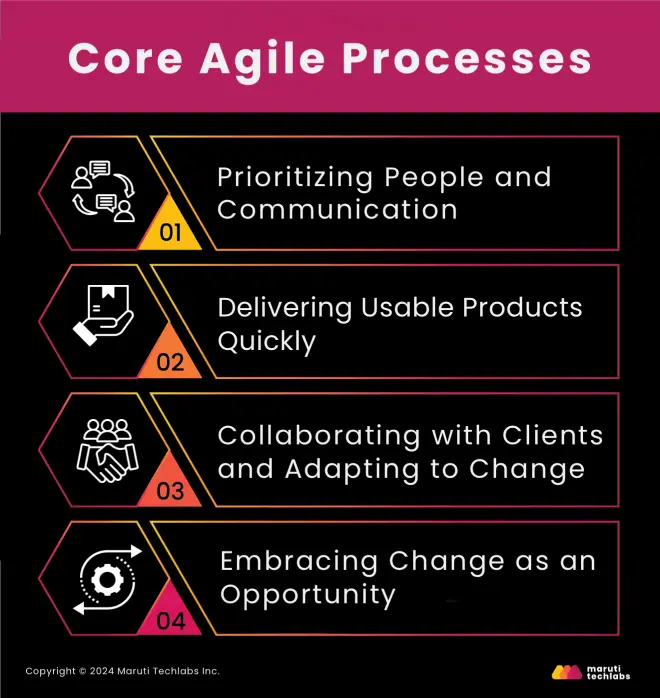
Agile is a mindset that transforms how you approach projects and encourages adaptability, collaboration, and continuous improvement.
Let’s break down the core principles of Agile and see how they play out in enterprises and startups looking to improve their digital capabilities.
Agile prioritizes direct communication and active team participation over rigid processes or tool reliance, enabling quick problem-solving, idea-sharing, and adaptability. For example, video conferences for daily stand-up meetings in distant software projects provide more flexibility than emails or software tools for problem-solving and team alignment.
Agile focuses on delivering functional software for user testing and feedback, keeping documentation minimal. Team communication and quick development take priority, allowing early user input. This approach enables immediate adjustments, ensuring the final product aligns with user expectations rather than getting bogged down in detailed specifications.
Agile prioritizes customer collaboration over strict contract negotiation. It focuses on working with clients to ensure the final result fits their changing requirements. Instead of rigidly following a contract, Agile teams work closely with clients, showcasing demos, gathering feedback, and making adjustments. This approach ensures the end product aligns with expectations and increases customer satisfaction.
Agile treats change as an opportunity rather than an obstacle. For example, if a client requests a new payment feature while developing an e-commerce platform. In that case, the Agile team can adjust priorities and incorporate this feature, keeping the product relevant and flexible. This adaptability ensures solutions are always in tune with current market demands and client’s needs.
Transitioning from Agile principles, let’s explore how DevOps complements this methodology.
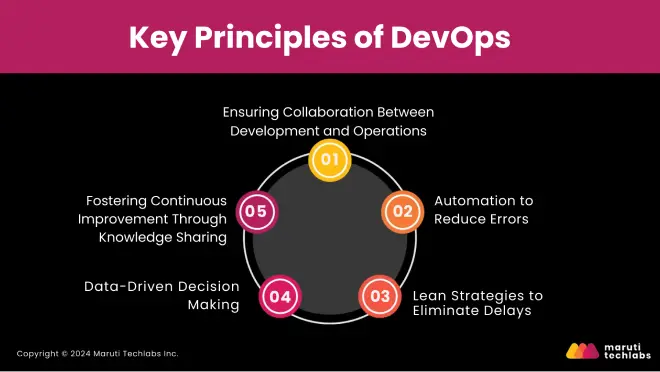
Unlike Agile, which primarily focuses on software development, DevOps extends beyond the entire software lifecycle, from development to deployment. Let’s break down the essential principles that define DevOps:
DevOps encourages collaboration between development and operations teams, ensuring smoother workflows and quicker problem-solving. By breaking down silos, it promotes shared responsibility, making every member accountable for the project’s outcome.
Example: When the development team creates a new feature, they work closely with operations from the start, sharing insights and challenges. This collaboration reduces deployment issues and speeds up delivery.
Automation is a crucial component of DevOps. It allows organizations to streamline repetitive activities while lowering the risk of human mistakes. DevOps enhances the consistency and efficiency of software delivery by automating testing, deployment, and monitoring processes.
Example: Suppose your team frequently releases software updates. Instead of manually testing every change, automated testing scripts run each time code is modified, ensuring quick issue identification and enabling faster deployments.
DevOps uses the Lean framework to minimize wastage and time consumed in software development. The most important objectives of simulation are improving the workflow and defining the main bottlenecks. As the jobs that add the most value are prioritized, this ensures only resources are used to create value.
Example: If your team discovers that deployment is slowed by waiting for approvals, automating procedures can expedite the process and enable faster releases without compromising quality. This results in faster delivery and more efficient workflows.
DevOps relies on data-driven decision-making. It continuously collects and analyzes data to identify areas for improvement. By acting on real insights, teams make informed adjustments throughout the software lifecycle.
Example: Monitoring application performance post-deployment reveals a feature causing slowdowns. Addressing this enhances overall system performance and ensures ongoing optimization.
DevOps encourages a culture of continuous learning, encouraging teams to share their experiences, achievements, and challenges. This approach helps drive ongoing improvements and ensures best practices are consistently applied.
Example: After a project, your team holds a session to discuss what went well and what didn’t. This open exchange identifies opportunities for improvement, benefits future projects, and promotes a culture of learning.
Let’s explore how the core practices of Agile complement these DevOps principles to create a seamless workflow.
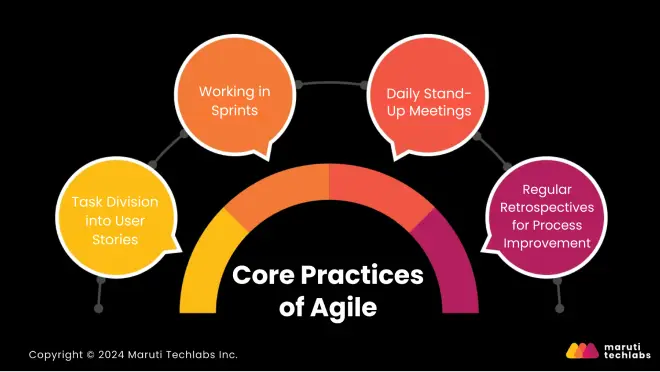
Here are the core practices that define Agile:
Agile focuses on breaking down work into smaller, manageable segments known as “user stories,” which reflect specific features from the end user’s perspective.
Rather than broadly stating, "Develop a payment system," an Agile team would create more targeted user stories such as, "As a customer, I want to add a credit card for payments”. This approach makes progress more organized and significant by guaranteeing that tasks are distinct, ranked, and aligned with the user's needs.
Agile teams operate in short cycles called “Sprints,” which usually last 1 to 4 weeks. With agile, each sprint allows the team to focus on completing a certain amount of work, thus having mobility and implementing incremental updates. For example, two weeks could be allocated specifically for designing and testing a new feature. This approach allows the team to deliver a functional product version regularly, more efficiently adapting to feedback and changes according to the planned schedule.
Stand-ups are speed meetings in which the team recalls what they have done, their problems, and what they will do. This transparency is the norm, and issues are detected early. When all team members are on the same page and share their progress and blockers, the team stays in sync. This alignment allows them to address issues quickly and efficiently.
At the end of each sprint, Agile teams conduct retrospectives to review what worked and what didn’t and identify areas for improvement. For instance, the team might realize that testing took longer than expected and brainstorm ways to streamline it in future sprints. This reflection fosters continuous learning and process optimization, making the team more efficient over time.
Now that we’ve covered Agile’s practices, let’s observe how DevOps complements and expands on them.
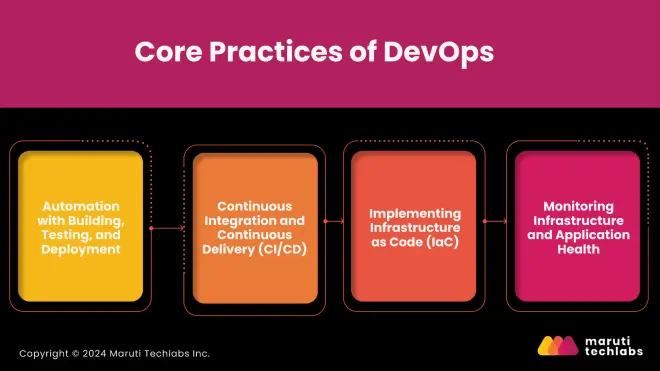
DevOps embraces better and faster ways of delivering software, and this is pivotal for the quick and more effective advancement of startups’ and companies’ digital strategies. This section will explore how DevOps practices accelerate software delivery and enhance collaboration.
DevOps relies highly on automation to improve software development processes. By standardizing specific procedures, teams can reduce human errors and increase deployment speed. This consistency helps streamline developing, testing, and deploying applications.
For example, a startup developing a new mobile app can use automation to quickly identify and fix defects, allowing them to launch the app faster. This technique is crucial to any firm looking to expand its operations while ensuring it does so correctly.
CI/CD is the backbone of DevOps, allowing teams to integrate code changes frequently and deploy them seamlessly into production. Consider an e-commerce platform that regularly updates its features.
Integrating CI/CD, every new feature or bug fix is quickly tested and deployed, ensuring customers consistently access their platform's best version without downtime. This adaptability helps businesses maintain a competitive edge by delivering high-quality software faster than traditional methods.
Infrastructure as Code (IaC) allows DevOps teams to manage and allocate infrastructure using code, simplifying automation and scaling operations. Consider a growing company that has to expand its server capacity to meet rising demand.
With IaC, they can quickly configure and deploy additional servers using predefined code, eliminating the need for manual setup. This agility enables firms to adapt to evolving needs while maintaining efficiency.
Continuous monitoring is vital in DevOps to ensure that applications and infrastructure function optimally. For instance, a fintech company relying on a secure and reliable application can leverage monitoring tools to track performance metrics and identify potential issues before they impact users. By proactively addressing these issues, the company maintains customer trust and prevents costly downtime.
While DevOps practices bring speed and efficiency, they share some fundamental principles with Agile. Let’s examine the similarities between DevOps and Agile.
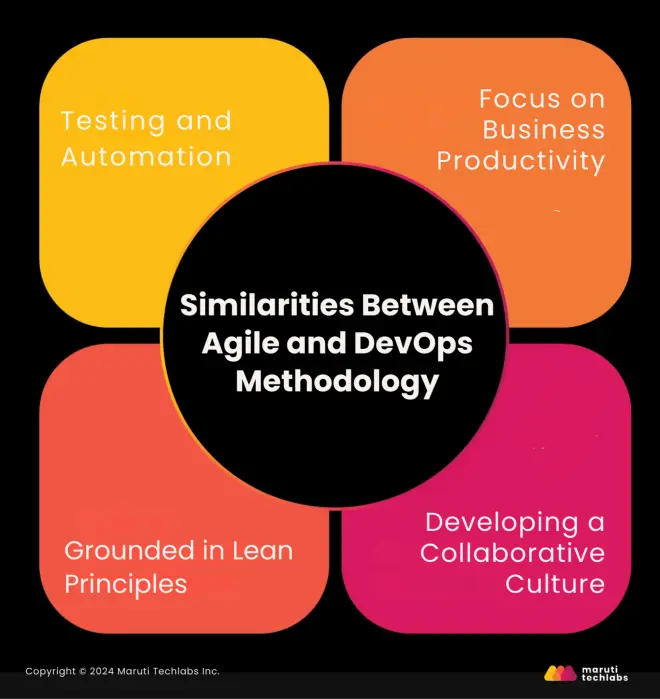
DevOps vs. Agile may seem like separate methodologies, but they share some fundamental principles that make them more alike than you might think. Here’s how they align:
Strict testing and automation are prioritized in Agile and DevOps. They operate in settings where quality, security, and speed are absolute requirements. Agile emphasizes consistent testing during development.
While DevOps goes one step further by automating the deployment process. This method guarantees software delivery without sacrificing security or stability. It translates into fewer issues, quicker releases, and a more reliable result for enterprises.
At their core, both Agile and DevOps aim to enhance productivity and efficiency. Agile enables development teams to concentrate on specific targets by breaking down projects into manageable tasks, resulting in more focused and productive workflows.
DevOps accelerates the deployment process, ensuring that software updates and features reach the market swiftly, which is crucial for maintaining a competitive edge. It also minimizes downtime, offering a seamless flow from development to deployment.
Collaboration is the foundation of both Agile and DevOps approaches. Agile encourages regular interaction throughout the team because every team member is focused on the same goals.
DevOps takes this concept and creates structures that conjoin development and operations teams, making it a strong follower of moral culture. Since problems are detected and solved rapidly due to this synchronization, teams have a smoother, more reliable process and a better fit to effect changes.
Agile and DevOps use the Lean framework as inspiration. Lean is based on efficiency, elimination of non-added value, and continuous enhancement. When applied in Agile and DevOps teams, practices can improve communication and provide more efficient working methods.
This basic understanding promotes a team's culture and helps it achieve its goal of delivering value to customers without unnecessary obstacles and delays.
While DevOps vs Agile have many similarities, it's crucial to understand their distinct roles and where they overlap to fully utilize the strengths of both methodologies.
Aspect | Agile | DevOps |
| Agile focuses mainly on software development, covering stages like planning, coding, and testing. It primarily ensures that the product development process adapts and responds to change. | It extends beyond software development to IT operations, infrastructure management, deployment, and maintenance. DevOps aims to streamline the entire software lifecycle, from development to deployment. |
| It emphasizes iterative and incremental development, delivering functional software in more minor, frequent releases. The goal is to adapt to changes quickly and gather user feedback at each stage. | DevOps prioritizes automation and continuous delivery to ensure fast, reliable, and consistent deployment. It focuses on seamless integration between development and operations, allowing for efficient end-to-end processes. |
| Agile involves smaller, cross-functional teams where members can adapt to various roles and responsibilities. This setup encourages versatility, communication, and collaboration within a compact group. | It requires larger, more specialized teams, typically with distinct roles such as developers, operations experts, testers, and system administrators. These specialized teams collaborate to manage different aspects of the project. |
Documentation | It uses lightweight, minimal documentation to maintain flexibility and adaptability. Agile encourages "just enough" documentation to keep the project moving forward efficiently. | DevOps observe detailed and comprehensive documentation to manage the complexity of integrating development and operations tasks. This ensures that all automation, infrastructure, and deployment processes are clearly defined and maintainable. |
Agile and DevOps have reshaped modern software development, each bringing unique strengths. Agile promotes adaptability, incremental development, and active client collaboration, enabling continuous feedback and improvement. DevOps complements this by breaking down silos between development and operations, driving automation, continuous integration, and rapid delivery.
By embracing Agile and DevOps, businesses can optimize workflows, reduce bottlenecks, and deliver software faster without sacrificing quality. Agile’s focus on user-centered iterations and DevOps’ streamlined automation ensures teams can respond to market demands efficiently and provide high-quality, reliable products.
At Maruti Techlabs, we implement Agile and offer DevOps Consulting following best practices to accelerate software development while maintaining top-notch quality. Whether you’re looking for custom software product development, mobile app development, or cloud migration, our experts can tailor a strategy that aligns with your business goals.
Contact us today, and let’s craft a digital roadmap that propels your business forward with speed, agility, and innovation.
Both are necessary. Agile and DevOps are essential to a whole software development life cycle since they optimize the development process and guarantee seamless deployment and continuous delivery.
We provide customized services that follow Agile and DevOps methodologies to ensure the effective development of your business goals.
With these methods, your business can respond quickly to changing market conditions and customer demands while achieving higher quality, speed, and flexibility.

